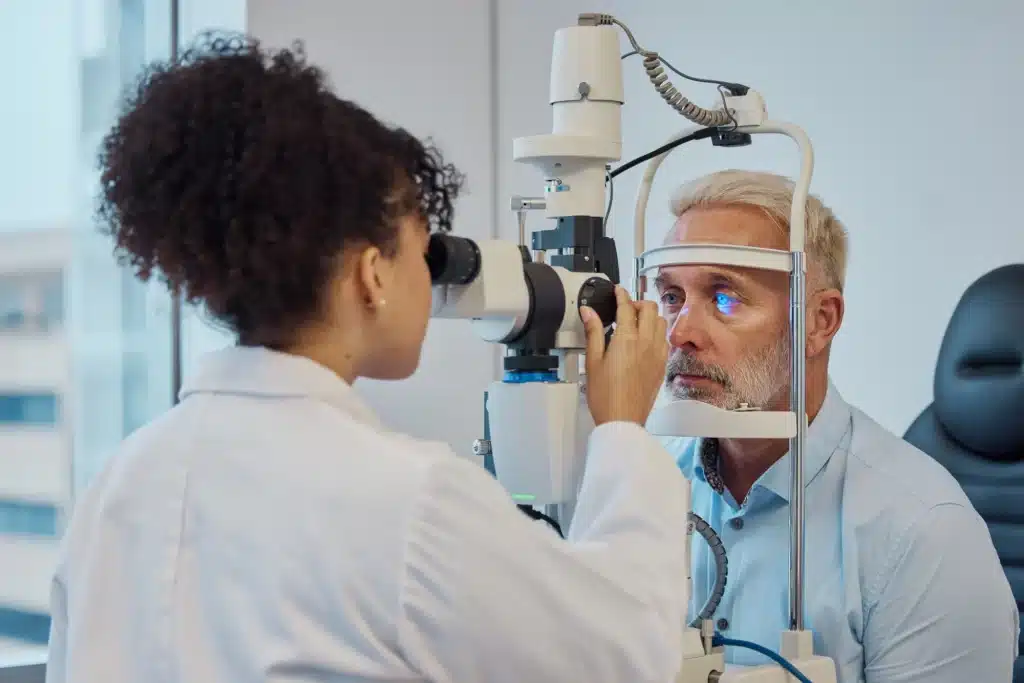Medically Reviewed by: Paul J. Stewart M.D.
Macular Degeneration Symptoms
Macular degeneration is an eye condition that affects the macula, the central part of the retina responsible for sharp, central vision. As this disease progresses, it can lead to a gradual or sudden loss of central vision, making it difficult to perform activities that require detailed sight, such as reading, driving, or recognizing faces.
One of the earliest and most common symptoms of macular degeneration is blurred or distorted central vision. You may notice that straight lines appear wavy or bent or that there are blank spots or dark areas in your central field of vision. Additionally, colors may appear dull or faded.
Other common macular degeneration symptoms include:
- Difficulty adapting to low-light conditions
- Increased sensitivity to glare and bright lights
- Difficulty recognizing faces or reading fine print
As the disease advances, these symptoms may become more pronounced, and you may experience a significant loss of central vision, leaving only peripheral vision intact.
In this blog post, we’ll dive deeper into the various symptoms of macular degeneration, how to recognize them, possible treatments for macular degeneration, and what steps you can take to manage this condition and preserve your remaining vision.
1. Blurred or distorted central vision
Distorted or sudden blurry vision is often one of the earliest noticeable symptoms of macular degeneration. Objects that you’re looking at directly may appear fuzzy, hazy, or lacking in detail and definition.
Additionally, distortion of central vision can cause straight lines to appear bent, curved, or wavy. This distortion can make things look misshapen or warped when viewed directly ahead. Blurred and distorted central vision can significantly impact daily activities and serve as an early warning sign that macular degeneration may be developing.
2. Blank spots or dark areas in the central field of vision
One concerning symptom of macular degeneration is the appearance of blank spots or dark areas in the central field of vision. As the macula degenerates, it can lead to localized areas of vision loss or impairment.
Individuals may notice blind spots or empty patches directly ahead where vision seems to be missing or blacked out. These blind spots can make it difficult to see things that are directly in front of you, as parts of the image essentially have holes or dark smudges obscuring them.
The size and location of these blank areas can vary, but they typically affect the central vision used for activities like reading, watching TV, or recognizing faces and fine details.
While blind spots can start small, they may grow larger as macular degeneration progresses. Noticing these new blank spots or dark areas should prompt an urgent visit to a macular degeneration doctor in Houston for evaluation.
3. Colors appearing dull or faded
As macular degeneration progresses, it can cause colors to appear dull, faded, or less vibrant than normal. The macula contains a high concentration of cone cells, which are photoreceptors responsible for color vision and the perception of fine detail. So, when the macula deteriorates due to age-related macular degeneration, it impacts the functioning of these cone cells.
As a result, colors may start to look muted, washed out, or lacking in richness compared to how they appeared previously. Vibrant hues can seem lackluster, and it may become difficult to discern subtle variations in color tone or shade. Additionally, colors can take on a brownish tint as the ability to perceive blue/violet light diminishes.
4. Difficulty adapting to low-light conditions
The macula plays a crucial role in enabling our eyes to adjust and function properly in varying levels of light. So, as the macula degenerates, it can impair the eye’s ability to transition and adapt smoothly when moving between brightly lit and dimly lit environments. This light adaptation issue can make it challenging to see clearly and discern details after entering a darker area from bright sunshine or an illuminated room. The eyes may struggle to adjust, leaving the person essentially “blind” for several long moments until their remaining photoreceptor cells can eventually catch up.
In some cases, the difficulty adapting to low lighting can also cause halos or glare to appear around light sources, further exacerbating the problem. This symptom can lead to feelings of clumsiness, lack of confidence, and increased risk of falls or missteps when navigating unfamiliar low-light areas. Early detection is key to implementing strategies to cope with this challenging aspect of age-related macular degeneration (AMD) eye disease.
5. Increased sensitivity to glare and bright lights
As the macula deteriorates, it impairs the eye’s ability to filter intense light sources. Bright sunlight, harsh interior lighting, or reflective glare can suddenly feel intensely bright and blinding.
This heightened sensitivity stems from the breakdown of the macula’s protective filters that normally shield the retina. Attempting activities in overly bright conditions induces temporary blindness, making it difficult to see.
Managing this symptom requires sunglasses, anti-glare filters, and controlling environmental brightness. Early recognition allows the implementation of coping techniques to preserve the remaining vision.
6. Difficulty recognizing faces or reading fine print
Difficulty recognizing faces or reading fine print is a frustrating symptom that many individuals with wet or dry macular degeneration experience. As we’ve mentioned, the macula is responsible for our central vision — the sharp, straight-ahead sight needed for tasks that require focusing on fine details.
As macular degeneration progresses, it can significantly impair the ability to discern the intricate features that allow us to easily distinguish one face from another. Facial attributes like eyes, noses, and mouths may appear blurred or distorted, making it challenging to recognize even close friends or family members.
Similarly, reading can become an arduous task, as the tight spacing and small lettering of books, magazines, and computer screens can become increasingly illegible.
7. Gradual or sudden loss of central vision
For some individuals, the loss of central vision occurs gradually over time. They may first notice blurred or distorted sight in the middle of their field of view. This can slowly progress to larger blank spots or blind areas until only peripheral side vision remains intact.
However, in other cases, central vision loss can occur rapidly and seemingly out of the blue. One day, they have normal sight, and the next, they are struck with a substantial impairment in their ability to clearly see what is directly in front of them.
Whether gradual or sudden, prompt medical treatment is crucial when this core vision symptom first appears in order to try to preserve remaining sight.
Can anything be done for macular degeneration?
Yes, there are treatments available that can help slow the progression of macular degeneration and potentially prevent further vision loss, though the condition cannot be fully cured or reversed. Some of the treatment options include:
- Anti-VEGF Injections: For wet (neovascular) age-related macular degeneration, injections of anti-VEGF drugs like ranibizumab (Lucentis), bevacizumab (Avastin), or aflibercept (Eylea) into the eye can help stop abnormal blood vessel growth and leakage which damages the macula. (Learn more about the newest dry macular degeneration treatments)
- Laser Therapy: Certain types of “cold” laser treatments, like photodynamic therapy, can help slow leakage from abnormal blood vessels in wet macular degeneration.
- Nutritional Supplements: For dry macular degeneration, specific high-dose formulations of antioxidant vitamins and minerals like the AREDS/AREDS2 supplements have been shown to reduce the risk of progression.
- Low Vision Aids: While not treating the disease itself, low vision devices like magnifiers, bright lighting, or text-to-speech software can help maximize remaining vision.
- Lifestyle Changes: Quitting smoking, exercising regularly, and eating a diet rich in leafy greens and fish may help reduce AMD risk and progression.
Early detection is key, as vision lost to late-stage macular degeneration cannot be restored. However, prompt treatment can often delay or minimize further central vision loss in many cases.
Continue reading: Which is worse: wet or dry macular degeneration?
Experiencing macular degeneration symptoms? Call Eye Center of Texas today!
Macular degeneration can cause symptoms like blurred central vision, distorted sight, blind spots, and difficulty recognizing faces or reading fine print. If you are experiencing any changes to your vision, especially in your central field of view, or have an abnormal Amsler grid, it’s crucial to get your eyes examined promptly by an ophthalmologist.
At Eye Center of Texas, our experienced eye surgeons utilize the latest diagnostic technologies to detect macular degeneration as early as possible and provide personalized treatment plans to help preserve your vision for as long as possible. With convenient locations throughout Texas (including Houston/Bellaire, Pasadena, Sugar Land, Clear Lake, Katy, and The Woodlands/Conroe), we make it easy to access top-quality macular degeneration care in your area.
Don’t delay if you notice any potential macular degeneration symptoms. Request an appointment with our ophthalmologists today to take the next steps toward safeguarding your precious vision.
More Helpful Articles by Eye Center of Texas:
- What is the Average Age for Cataract Surgery?
- Pros and Cons of Photorefractive Keratectomy Surgery
- LASIK Surgery Age Limit
- What to do About Double Vision After Cataract Surgery
- Why is My Eyesight Getting Worse?
Related Articles
Financing Options Available
Apply today to find a financing option that meets your needs.
Our Locations
Houston/Bellaire
6565 W. Loop S., Suite 650Bellaire, TX 77401
Medical Office:
713-797-1010
Medical Fax:
713-357-7276
LASIK/Near Vision:
Office: 713-395-1515
Fax: 713-357-7278
Pasadena
4415 Crenshaw RoadPasadena, TX 77504
Medical Office:
281-977-8800
Medical Fax:
281-977-8877
Sugar Land
15200 S.W. Freeway, Suite 130Sugar Land, TX 77478
Medical Office:
281-277-1010
Medical Fax:
281-277-4504
Clear Lake
455 E. Medical Center Blvd., Suite 110Webster, TX 77598
Medical Office:
281-332-1397
Medical Fax:
281-282-9152
Katy
Greenhouse Medical Plaza2051 Greenhouse Road, Suite 110
Houston, TX 77084
Medical Office:
346-547-7070
Medical Fax:
281-214-2971
The Woodlands/Conroe
100 Medical Center Blvd., Suite 118Conroe, TX 77304
Medical Office:
936-647-1610
Medical Fax:
936-647-1620


